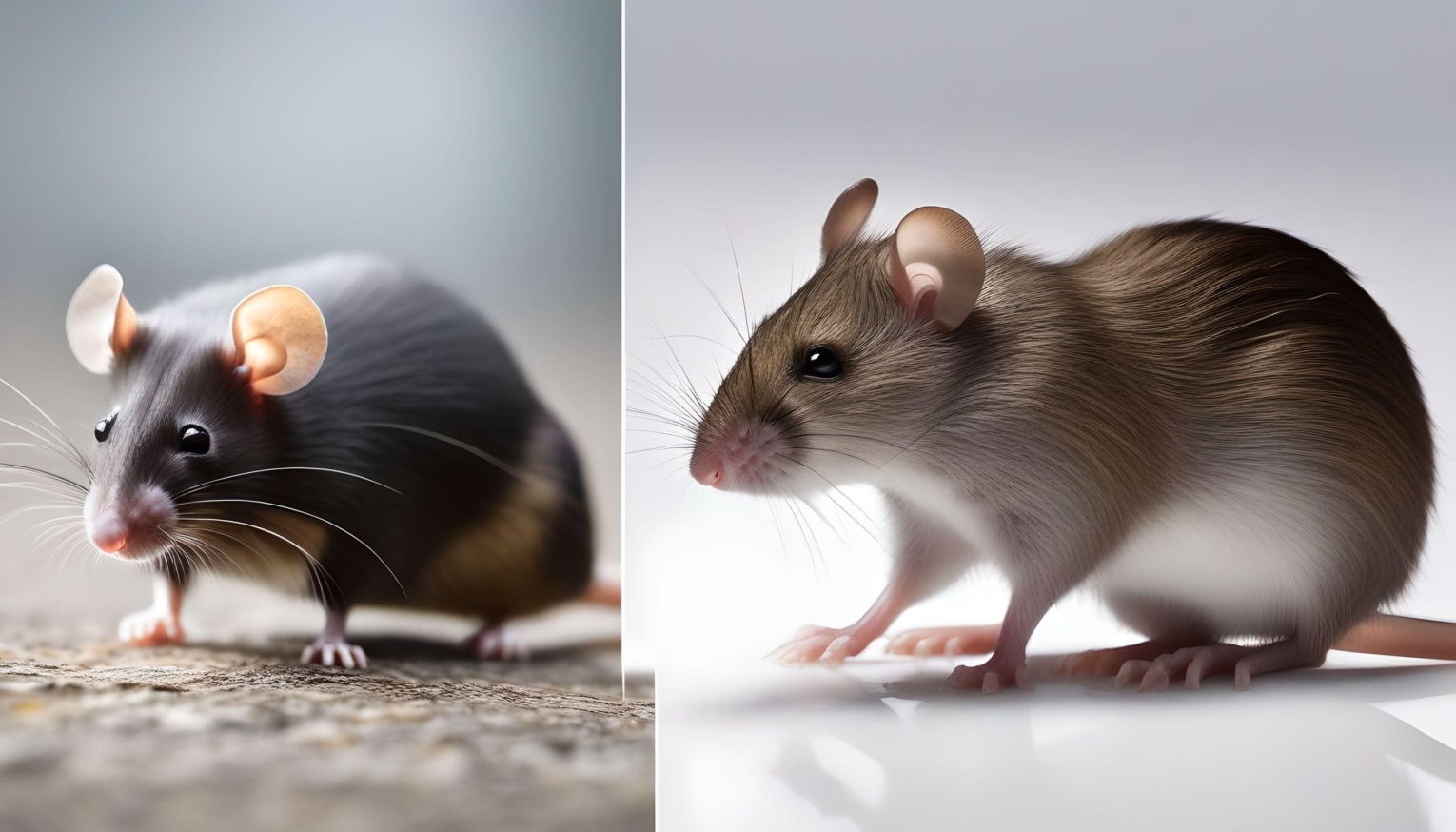7 Major Difference between Rat and Mouse | Food, Habitat, Appearance, Health
Rats and mice are two of the most common and well-known types of rodents. Both have a history of being disease carriers and for being able to scamper and sneak around. Rats and mice are quite similar, but they also differ significantly in a variety of ways. The differences between rats and mice, including their physical traits, behaviours, and habitats, will be discussed in this Article.
Difference between Rat and Mouse:
Major and important Differences between Rat and Mouse is given below:
| Rats | Mouse | |
|---|---|---|
| Size | Typically much larger (up to 18 inches) | Usually only 3-4 inches long |
| Body Shape | More elongated body shape with longer snouts and tails | Smaller and rounder body shape with shorter snouts and tails |
| Fur | Shaggier, rougher fur with furry tails | Softer fur with hairless, scaly tails |
| Behaviour | More aggressive and territorial, tendency to burrow | More social and curious, a tendency to live in large groups |
| Habitat | Often found in urban or suburban areas, as well as agricultural areas | More commonly found in rural areas, as well as buildings and structures |
| Health Risks | Associated with several serious diseases, including bubonic plague, hantavirus, and leptospirosis | Capable of carrying and transmitting disease, including hantavirus and salmonellosis |
| Prevention and Control | May require professional pest control help, sealing cracks and openings, removing sources of food and water, using traps | Similar prevention and control methods as for rats |
I. Unveiling Physical Characteristics
1. Size Matters: Rat vs. Mouse
Rodents come in various sizes, and understanding the nuances can be crucial. Rats generally exhibit larger dimensions than mice, with variations in length and weight. Delving into the specifics, this section provides an overview of size differences and essential measurements for accurate identification.
2. Fur and Coloration
Beneath the seemingly simple exterior lie intricate details that aid in species identification. Explore the different textures and colors of rat and mouse fur, gaining insights into the role these features play in distinguishing between the two species.
3. Ears, Tail, and Facial Features
Spotting the differences extends beyond size and fur. This section dissects the distinctive characteristics of rodent ears, the role of tails in differentiation, and unique facial features that set rats and mice apart.
II. Taxonomy and Species Identification

1. Taxonomic Classification
Embark on a journey into rodent taxonomy, gaining an understanding of where rats and mice fit into the broader classification of rodents. Uncover the hierarchical order that places these species within the intricate web of rodent diversity.
2. Common Species
Rodents are not a homogenous group; this section highlights popular rat and mouse species, shedding light on their geographic distribution and prevalence. Navigate the diverse world of these rodents and appreciate the unique characteristics each species brings to the table.
III. Behavioral Differences

1. Social Structure
Comparing societal structures unveils the intricate social behaviors exhibited by rats and mice. Gain insights into the importance of social structures within each species, understanding how these behaviors influence their interactions and dynamics.
2. Feeding Habits
Dietary preferences shape the ecological impact of rodents. Analyze and contrast the diets of rats and mice, exploring how their feeding habits influence environments and ecosystems.
3. Nesting and Shelter
Rodents are skilled architects of their homes. Examine the nesting behaviors of rats and mice, unraveling the preferences they exhibit in choosing shelter environments. Understand the significance of these behaviors in the context of pest management and ecological balance.
IV. Habitat Preferences

1. Urban vs. Rural Environments
The adaptability of rats and mice across settings is a testament to their resilience. Delve into how these rodents navigate urban and rural environments, exploring the factors that influence their habitat preferences.
2. Niche Occupancy
Beyond adapting to environments, rats and mice play specific roles in ecosystems. This section explores the niches these rodents occupy, shedding light on the dynamics of coexistence and competition within diverse ecological settings.
V. Reproduction and Life Cycle
1. Reproductive Rates
Family planning takes a unique turn in the rodent world. Contrast the reproductive rates of rats and mice, uncovering the factors that influence their breeding frequency. Gain insights into the challenges and opportunities these rates present in pest management.
2. Gestation and Maturation
From conception to maturity, the life cycle of rats and mice holds intriguing details. Explore the duration of gestation in these rodents and the maturation process, offering a comprehensive view of their life expectancy and reproductive journey.
Physical Difference between Rat and Mouse
One of the most Common differences between rats and mice is their size. Rats are mostly much larger than mice, with some species of rats reaching lengths of up to 18 inches (including their tail). Mice, on the other hand, are usually only around 3-4 inches long (not including their tail). Also, their size, rats also have a more elongated body shape, with longer snouts and tails than mice.
Another important physical difference between rats and mice is their fur. Rats mostly have shaggier, rougher fur than mice, and their tails are also covered in fur. Mice, on the other hand, have much softer fur, and their tails are usually hairless and scaly.
Behavioural Difference between Rat and Mouse
While both rats and mice are recognised for their abilities to scamper and sneak about, their behavioural inclinations are rather different. Rats, for example, are more territorial and aggressive than mice. They are also noted for their proclivity to dig and construct complex tunnel structures for nesting and protection.
Mice, on the other hand, are more sociable animals that live in huge groups or colonies. They also tend to be more interested and adventurous than rats and are less prone to be hostile towards people or other animals.
Habitat Difference between Rat and Mouse
Rats and mice also have different habitat preferences. Rats are often found in urban or suburban areas, where they can scavenge for food and find shelter in buildings, sewers, and other structures. They are also known to thrive in agricultural areas, where they can feed on crops and other farm produce.

Mice, on the other hand, are more commonly found in rural areas, where they can live in fields, meadows, and other outdoor environments. They are also known to seek shelter in buildings and structures but are less likely to do so than rats.
Health Risks:
It is well known that rats and mice may both harbour and spread disease. Especially rats are associated with a variety of fatal diseases, including leptospirosis, the hantavirus, and the bubonic plague. They could also be carrying fleas, which can make us sick both people and animals.
Salmonellosis and the hantavirus are only two of the illnesses that mice may harbour and transmit. Moreover, they could be tick and flea carriers, which may be dangerous for both people and pets.
Prevention and Control:
If you suspect a rat or mouse infestation, you must act quickly to avoid and control the problem. Sealing up any holes or openings in your house or structure, removing supplies of food and water, and utilising traps or other control measures to eliminate the rats are all examples of what you could accomplish.
If you have a rat infestation, you need to be extra cautious because rats can be aggressive and transmit serious diseases. In some cases, a professional pest control firm may be required to assist you in safely and successfully removing the infestation.
Conclusion and Final Words:
Rats and mice may look similar, but they are very different in many ways. From physical traits and behaviour to habitat preferences and health hazards, these two rodent species have distinct traits and tendencies that set them apart. Understanding these differences can help you better protect yourself and your property
FAQ on the Difference between Rat and Mouse-
-
How can I tell the difference between a rat and a mouse?
The easiest way to tell the difference is by their size and body shape. Rats are usually much larger and have an elongated body shape, with longer noses and tails. Mice are smaller and rounder, with shorter snouts and tails.
-
What is the difference between rat and mouse droppings?
Rat droppings are usually larger and more oval, while mouse droppings are smaller and more cylindrical. Rat droppings can also contain hair, as rats groom themselves more often than mice.
-
Are rats or mice more dangerous to humans?
Both rats and mice can carry and transmit diseases, so it is important to take precautions to avoid contact with their droppings, urine and saliva. But rats are associated with more serious diseases, including bubonic plague, hantavirus and leptospirosis.
-
Can rats and mice interbreed?
No, rats and mice are two different species and cannot interbreed.
-
Do rats and mice have different diets?
Although both rats and mice are omnivores and eat very different foods, they have different eating habits. Rats are known to eat grains, fruits, vegetables and meat, while mice prefer seeds and grains.
-
Can rats and mice live together?
Although it is technically possible for rats and mice to live together, it is not a good idea. Rats are more aggressive and territorial than mice and can attack or even kill mice if they feel threatened.
-
Can I keep rats or mice as pets?
Yes, both rats and mice can make great pets for the right person. However, it’s important to do your research and make sure you can provide the right care and environment for your pet.
-
How can I prevent a rat or mouse infestation?
To prevent a rat or mouse infestation, it is important to seal any cracks or openings in your home or building, remove food and water sources, and use traps or other control methods to remove any rodents that enter. Regular cleaning and maintenance can also help prevent rodents from living in your home.
Recommended:





























